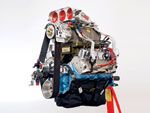
This story is certain to generate a ton of controversy among those who believe the Pontiac V-8 is a great low-revving torque factory, but little more. For sure the Pontiac 389 and 421 enjoyed their fair share of racing success back in the days of factory-assisted NASCAR circle track and NHRA dragstrip competition, culminating with the awesome '63 421 Super Duty Catalina. But an antiperformance corporate policy arrived by 1964, and hard-core Pontiac engine development ground to a halt. All the experimental Hemi head, SOHC, DOHC, and aluminum block programs were unceremoniously canceled. Oh what could have been.
Sure, the '60s and early '70s brought the legendary Tri-power 389, Ram Air 400, 455 H.O. and 455 S.D. motors, but these were essentially super-performance street packages with mainly cast-steel guts, not race engines detuned for street use like certain competing forged-gut Detroit powerhouses. The heads were good, but the durability of the short-block was always an issue.
Don't tell any of this to Bill Taylor of Oceanside, California, who swears by stock factory castings and says the Pontiac 400/455 can go over 7,500 rpm and live while putting out enough power-up to and including blown alcohol-to keep up with just about any competitor. The wild-eyed automotive machinist knows of what he speaks. He grew up street racing a '68 GTO-nicknamed Bad Medicine-in his native Lincoln, Nebraska, back in the early '80s. The Goat started out with a swapped-in 455 with a RAIV cam, a Muncie four-speed, and a 4.11-geared 12-bolt. Taylor claims it was virtually undefeated, and he soon garnered a reputation as the man to beat. Of course, this attracted bigger fish, so he stepped up to nitrous, then 13.5:1 slugs on alcohol via a Ron's "Flying Toilet," then alcohol with nitrous-all the while relying on stock 400 and 455 block and crank castings. You see where this is going. When it was all done, Taylor's nontubbed, 3,300-pound GTO was running 9.8s with a 400-horse shot of nitrous.
But it kept breaking. No, not the Pontiac engine, but the Muncie four-speed and 12-bolt were constantly on the fritz. So a 4.56-geared Dana 60 with a spool and a Clutch Turbo were added. The Dana needs no explanation, but the clutch-equipped Turbo 400 is an unusual choice. Taylor said he tried a conventional Turbo 400 but couldn't find a converter that didn't slip at the top end.
So he got a deal on a vintage B&M Clutch Turbo and hasn't looked back since. With the driveline in order, Taylor sought even more power from the stock two-bolt block and mildly prepared cast crank under the hood.
By the time he stepped up to the 6-71 supercharger, Taylor had moved his life to Oceanside, California, to "make a new start." When asked if a few too many chats with the Nebraska State Police had something to do with the cross-country move, he smiled silently. One thing that didn't change was his devotion to stock Pontiac block and crankshaft castings. With the 455 now sporting 13.5:1 slugs, a 6-71 huffer, and a steady diet of methanol, the GTO ran an astonishing 8.80 at 154 mph-at 8,000 rpm-before a packed house at Pomona during a Goodguys meet-so there are witnesses.
Then Taylor got greedy. After posting a blistering 5.57-at-130 pass at the Barona eighth-mile Antique Drags in 2005, he got caught up in the chase for the event's top-speed trophy. In a bid to edge out a competing, nitrous-chugging, 1,800-pound Chevy, he added 80 percent nitro to the usual 100 percent methanol fuel load. The plan worked-for the first car length. As driver Chris New explains, "Usually the car hits the 8,000-rpm rev limiter at the 60-foot mark, then I shift into Second. But with the added cylinder pressure of nitromethane, it was at eight grand within 20 feet." Then the car settled down and parts began exiting. Yep, the tried-and-true blown-alcohol 455 finally scattered after several seasons of doing the seemingly impossible. The carnage was extreme, with the stock cast crank breaking in half and the entire No. 1 cylinder barrel blowing off the block.
Taylor's story is sure to add fuel to the Pontiac controversy. We can hear those who follow conventional wisdom saying, "You can't do that! The stock block is too fragile, the massive main bearing journals are too big for safe oil flow, and the cast-steel crank is too delicate!" Well, Taylor's heard it all before and seems to be getting away with it.
We decided it'd be enlightening to ask Taylor to show us the innermost details of his new 400-cube blown-fuel Pontiac mill. He says his choice of the 400 rather than his tried-and-true 455 is based on the fact that he already had the knife-edged 400 crankshaft ready to go. Plus, as he puts it, "With the blower and nitro, the motor isn't going to miss a measly 55 ci." So enjoy this tour through perhaps the world's only modern, blown-fuel Pontiac.